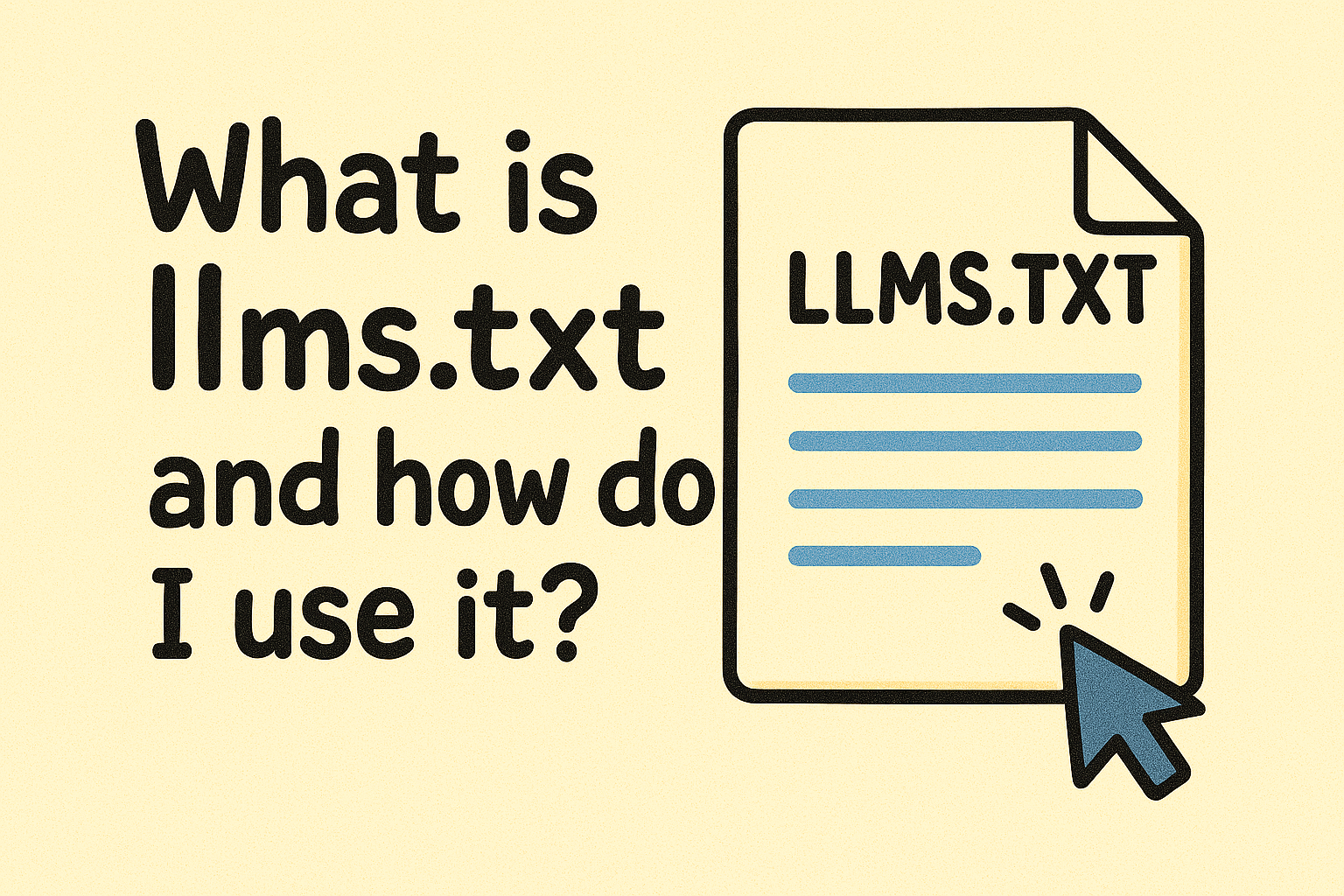LLMs.txt What is it and How Do I use it on my Website?
What is llms.txt?
“llms.txt” is a file proposed to standardize how websites share information with large language models (LLMs). This markdown file, placed at a website's root (e.g., https://example.com/llms.txt), offers LLMs concise background, guidance, and links to detailed markdown files, making it easier for them to understand and use the site's content. This is particularly useful for development environments needing quick access to documentation.
How Do I Use It?
For Website Owners: Create a markdown file named “llms.txt” at your website's root. Structure it with:
- An H1 header for the site name.
- A blockquote summarizing the site's purpose.
- Optional sections for additional details.
- H2-delimited lists of resource links, including an “Optional” section for secondary information.
For LLM Developers: Access “llms.txt” from websites to retrieve curated, LLM-friendly content, enhancing context for better interaction with the site.
An unexpected detail is that tools like “llms_txt2ctx” can process this file to generate context for LLMs, and platforms like Mintlify have integrated support, boosting its adoption.
Survey Note: Comprehensive Analysis of llms.txt and Its Usage
This note provides an in-depth exploration of “llms.txt,” likely a typo for “llms.txt,” a proposed standard to enhance large language model (LLM) interaction with websites. The analysis covers its definition, purpose, structure, and usage, drawing from recent proposals and community discussions, with a focus on its relevance as of March 28, 2025.
Background and Definition
The term “llm.txt” was initially unclear, but research strongly suggests it refers to “llms.txt,” a markdown file proposed to standardize how websites provide LLM-friendly content. This proposal, detailed at The /llms.txt file – llms-txt, aims to address the limitation of LLMs' context windows, which struggle to process entire websites due to complex HTML, navigation, ads, and JavaScript. “llms.txt,” located at the root path /llms.txt (or optionally in a subpath), offers a curated index for LLMs, providing concise summaries and prioritized links to machine-readable resources, as outlined in The Role and Functionality of llms.txt in LLM-Driven Web Interactions.
Purpose and Use Cases
The primary purpose of “llms.txt” is to optimize LLM inference by reducing noise and surfacing high-value content, distinct from traditional /robots.txt and /sitemap.xml, which focus on search engine optimization. It is particularly valuable for use cases like development environments, where LLMs need quick access to programming documentation and APIs, as noted in LLMS-txt. Other applications include software documentation, business structures, e-commerce, education, and personal websites, enhancing LLM-driven interactions across diverse sectors.
Structure and Format
The “llms.txt” file follows a strict markdown schema for readability by both humans and LLMs, enabling programmatic parsing. Its structure includes:
- A required H1 header for the site’s name.
- A blockquote summarizing its purpose.
- Freeform sections for additional context, without headings.
- H2-delimited resource lists categorizing links to markdown documents, APIs, or external resources.
- A reserved “## Optional” section for secondary links that can be omitted when context length is constrained.
This format ensures balance, as seen in examples like FastHTML docs llms.txt, which provides practical implementation insights.
| Aspect | Details |
|---|---|
| Definition | A proposed standardized /llms.txt markdown file to provide LLM-friendly content for websites, located at the root path /llms.txt (or optionally in a subpath), to help LLMs use websites at inference time. |
| Purpose | Offers brief background information, guidance, and links to detailed markdown files for LLMs, especially useful for development environments, software documentation, business structures, e-commerce, education, and personal websites. |
| Format | Uses Markdown with a specific structure: – Required H1 with project/site name – Blockquote with short summary – Zero or more markdown sections (no headings) for details – Zero or more H2-delimited “file lists” with hyperlinks [name](url) and optional notes, including an “Optional” section for skippable secondary information. |
| Usage Examples | – FastHTML docs llms.txt – Example HTML docs page: regular, markdown version – Markdown version of fastcore’s docments: HTML, markdown |
| Processing Tools | – llms_txt2ctx for parsing and generating LLM context, creating llms-ctx.txt and llms-ctx-full.txt for FastHTML. |
| Integration Tools | – JavaScript Implementation – vite-plugin-llms for serving markdown files. |
| Community Engagement | – GitHub repository: https://github.com/AnswerDotAI/llms-txt with overview – Discord channel: https://discord.gg/aJPygMvPEN for discussions. |
| Relation to Standards | Coexists with /robots.txt and /sitemap.xml, focusing on curated LLM-readable content rather than search indexing or all indexable pages. |
This table, derived from The /llms.txt file – llms-txt, encapsulates the proposal's key aspects.
Usage for Website Owners
For website owners, implementing “llms.txt” involves creating the file at the root directory, following the specified structure. Tools like Generate llms.txt can assist in generation, while How to Create an llms.txt File for Any Website offers practical guidance. The file can coexist with existing standards like /robots.txt, focusing on LLM optimization rather than search indexing.
Usage for LLM Developers
For LLM developers, “llms.txt” serves as a resource to access curated content from websites. By retrieving the file, developers can enhance LLM prompts with relevant context, improving accuracy in tasks like documentation retrieval or API interaction. The proposal notes that “llms-full.txt,” an alternative, includes all detailed content in one file, though its size may exceed LLM context windows for extensive documentation, as discussed in LLMS-txt.
Community and Adoption
The “llms.txt” proposal has gained traction, with platforms like Mintlify adding support, as highlighted in LLMs.txt Explained | Towards Data Science. Community engagement is facilitated through the GitHub repository GitHub – AnswerDotAI/llms-txt and a Discord channel Discord, fostering discussions and tool development like vite-plugin-llms for serving markdown files.
Conclusion
As of March 28, 2025, “llms.txt” represents a promising standard for enhancing LLM-web interactions, with clear guidelines for implementation and growing community support. Its structured approach ensures accessibility for both website owners and LLM developers, potentially shaping future AI-driven web experiences.



